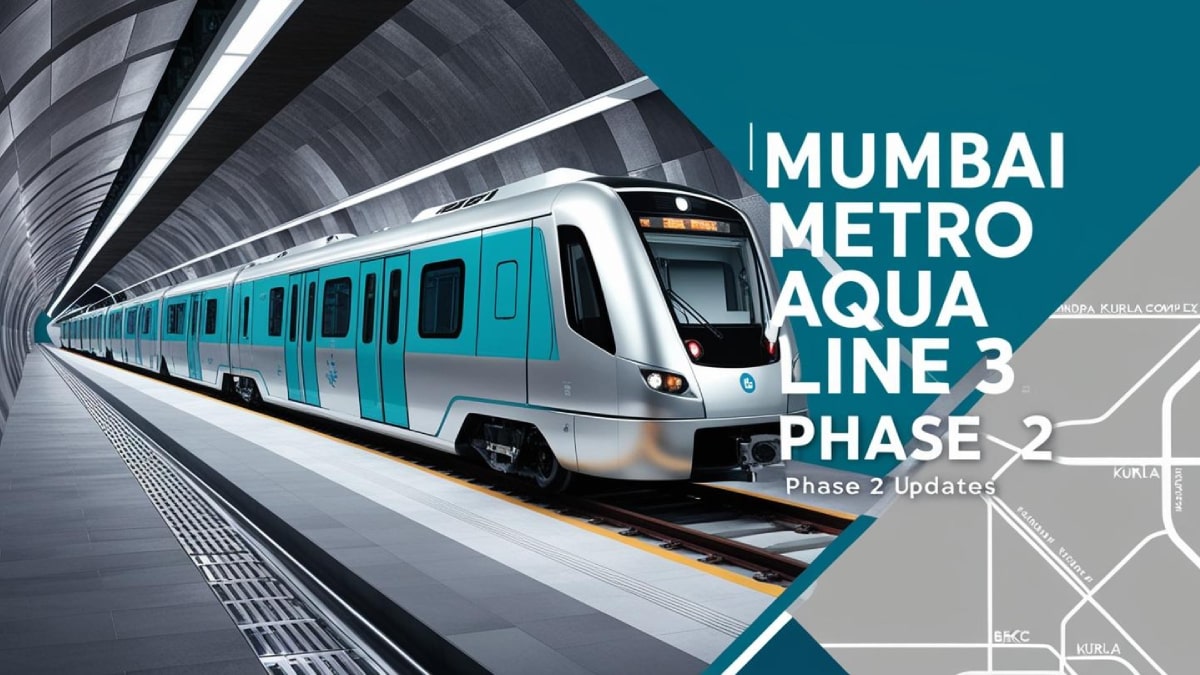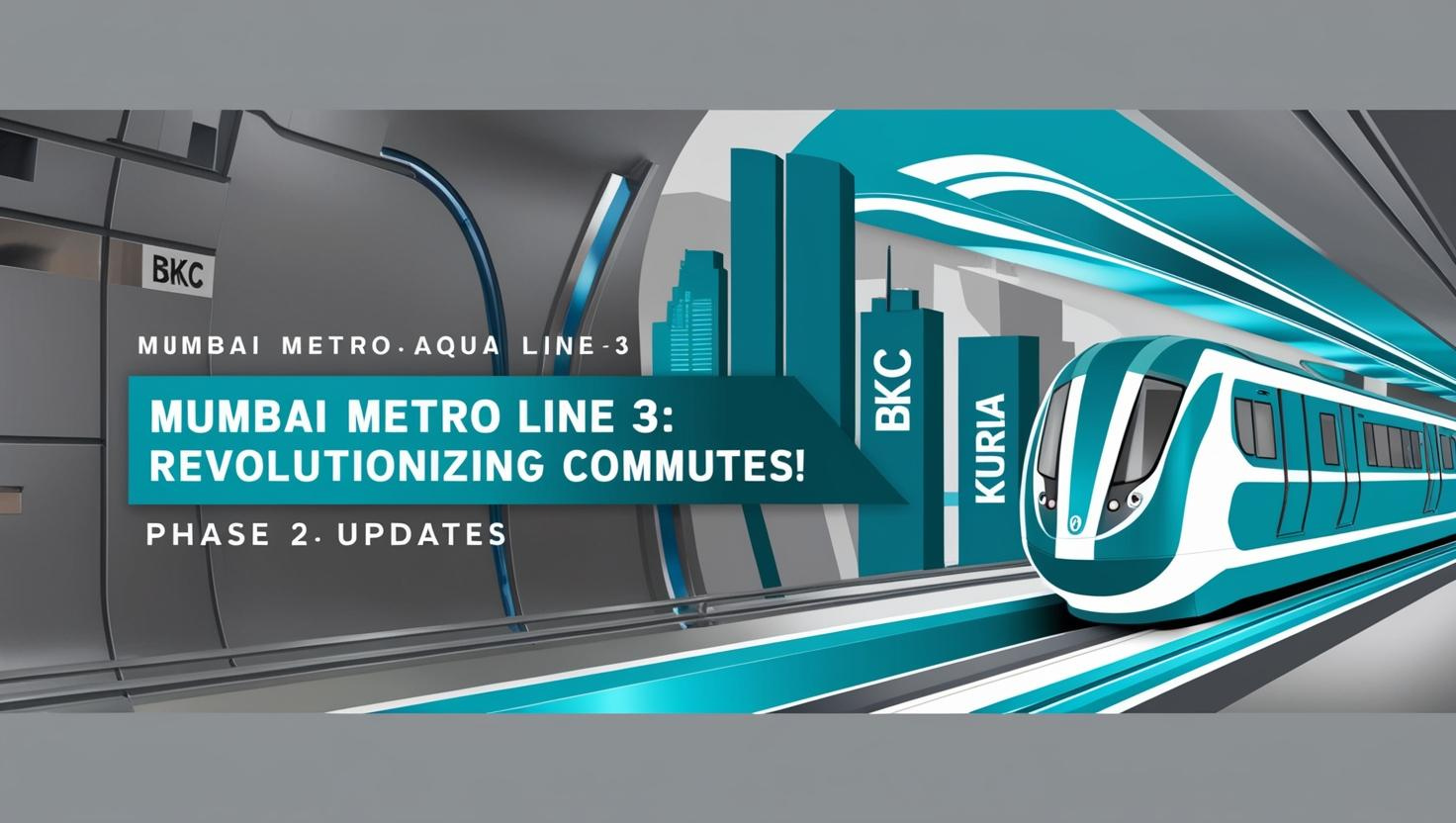Mumbai Metro 3 Aqua Line Phase 2: The Latest Updates, Expected Completion, and Impact on City Life

Mumbai, known for its bustling streets and growing infrastructure, is on the verge of a significant urban transformation with the ongoing development of the Mumbai Metro. Among the most awaited projects is the Mumbai Metro Line 3, popularly known as the Aqua Line, which is expected to transform city transportation. In this blog, we’ll explore the latest updates regarding Phase 2 of the Aqua Line, its expected completion, and its profound impact on Mumbai city life.
What is the Mumbai Metro 3 Aqua Line?
The Mumbai Metro Aqua Line 3 is one of the most ambitious metro projects under the Mumbai Metro network. It aims to connect Colaba in South Mumbai to SEEPZ in the Andheri area, passing through some of the most heavily populated and traffic-congested zones, including Bandra Kurla Complex (BKC) and Kurla. The Aqua Line will be an underground metro system, with several metro stations strategically located to provide easy access to commuters.
Expected Completion and Timelines for Phase 2
The Mumbai Metro Rail Corporation Ltd. (MMRCL) has shared significant updates regarding the progress of the Metro Line 3 Aqua Line, particularly its much-anticipated Phase 2. This phase will connect Bandra Kurla Complex (BKC) to Cuffe Parade and is expected to commence operations by May 2025.
Understanding the Aqua Line Phases
The Aqua Line is being developed in three phases, with each phase extending the metro’s reach across Mumbai's key residential, commercial, and cultural hubs.
Phase 1: Aarey JVLR to Bandra Kurla Complex (BKC)
The first phase began operations on October 7, 2024, connecting suburban and business districts. The route includes:
➤ Aarey JVLR
➤ Seepz
➤ MIDC Andheri
➤ Marol Naka
➤ Chhatrapati Shivaji Maharaj International Airport (T2)
➤ Sahar Road
➤ Chhatrapati Shivaji Maharaj International Airport (T1)
➤ Santacruz Metro
➤ Bandra Colony Vidhyanagar
➤ BKC
This phase has made significant strides in easing traffic congestion by providing seamless connectivity between Mumbai’s western suburbs and the business hub of BKC.
For complete details Exploring Mumbai Metro Line 3: Route Map, Stations, and Opening Status
Mumbai Metro 3 Aqua Line Phase 2 Now Open: Latest Updates and What Commuters Need to Know
Mumbai’s much-anticipated Metro Line 3 Aqua Line has made a significant leap with the opening of Phase 2. Connecting Bandra Kurla Complex (BKC) to Worli, this section of the line is designed to address the growing transportation needs of Mumbai’s business and residential districts. Officially launched on May 9, 2025, Phase 2 will make daily commutes smoother and faster for thousands of Mumbaikars.
BKC to Worli Metro Line 3 Opening: Route, Stations, and Travel Tips
The newly launched Phase 2 of the Aqua Line connects key areas like Dharavi, Dadar, Siddhivinayak, and Worli, significantly enhancing connectivity between residential and commercial hubs. The route includes major stations such as Dadar, Worli, and Siddhivinayak, all strategically placed to reduce travel time across busy zones. As the metro system opens for public use, it's crucial to understand the best routes, transfer points, and how to make the most of this new service.
Benefits of the Mumbai Metro Line 3 for Daily Commuters
With Mumbai Metro Line 3 officially open, passengers may look forward to a number of advantages:
- Reduced Traffic Congestion: This metro line will ease road traffic, especially in busy corridors like BKC, Worli, and Dadar.
- Faster Travel Times: It will cut down travel times, offering a faster alternative to buses and private vehicles.
- Comfortable, Eco-Friendly Commute: Fully air-conditioned trains will provide a more comfortable and reliable travel option, reducing reliance on the overcrowded local trains and buses.
Why the BKC to Worli Aqua Line 3 is a Game-Changer for Mumbai's Traffic
The Aqua Line 3 will ease congestion in some of Mumbai’s busiest areas, particularly the Bandra Kurla Complex (BKC). With its central location connecting multiple hubs, this section of the metro promises to significantly improve mobility for both office-goers and residents. By providing a modern, underground metro route, the Aqua Line 3 is set to reduce the number of vehicles on the roads, directly combating traffic congestion.
Fare Structure and Ticketing Options for Mumbai Metro Line 3
The fare system for the Mumbai Metro Aqua Line 3 is designed to be affordable for the general public. Here’s a quick overview of the pricing:
- Single Journey Fare: Starting from ₹10 and going up to ₹60, depending on the distance.
- Online Ticketing: Mumbai Metro has introduced a user-friendly Yatri - City Travel Guide app for online ticket purchases.
Complete Station List for Mumbai Metro Line 3 Phase 2
For commuters looking to familiarize themselves with the new route, here’s a complete list of stations in Phase 2 of the Aqua Line:
➤ Dharavi
➤ Shitala Devi Mandir
➤ Dadar
➤ Siddhivinayak Temple
➤ Worli
➤ Acharya Atre Chowk

Phase 3: Worli to Cuffe Parade
The final phase will connect Mumbai’s southernmost tip, linking important cultural, business, and residential areas. The stations on this route include:
➤ Science Centre
➤ Mahalakshmi
➤ Jagannath Shankar Sheth Metro
➤ Grant Road
➤ Girgaon
➤ Kalbadevi
➤ Chhatrapati Shivaji Maharaj Terminus Metro (CSMT)
➤ Hutatma Chowk
➤ Churchgate
➤ Vidhan Bhavan
➤ Cuffe Parade
This phase will integrate the metro network with Mumbai's historic and financial districts, offering a modern transit solution to areas often plagued by heavy traffic.
Safety and Security Measures on the Aqua Line
The Aqua Line will be equipped with state-of-the-art safety and security features, ensuring a secure commuting experience:
- CCTV Surveillance: Monitoring across trains and stations.
- Emergency Response Systems: Easily accessible alarms and communication devices.
- Fire Safety: Advanced smoke detection and suppression systems in underground facilities.
- Trained Security Personnel: Present at all key stations for assistance.
Impact on Mumbai City Life
The introduction of Mumbai Metro Line 3 is set to revolutionize city commuting. Here are a few ways it will impact Mumbai:
- Reduced Traffic Congestion: With stations like BKC Bandra Kurla Complex, the Aqua Line will significantly reduce the number of cars on the road. It will offer a reliable and fast alternative to metro routes in Mumbai, particularly for those who commute to key business districts.
- Seamless Connectivity: The BKC complex and Bandra Kurla Road are major business hubs, and the new underground metro will make it easier for professionals to access these areas. The metro stations will be easily accessible to various forms of transportation, such as buses, subway stations, and airport metro stations.
- Affordable and Efficient Travel: With Mumbai Metro tickets being reasonably priced, the metro will provide an affordable way for daily commuters to travel across the city. The introduction of metro stations with parking will also make it convenient for people to park their vehicles and board the metro.
- Boost to Real Estate Development: Areas near metro stations, such as Bandra Kurla, are expected to see a rise in property value. The improved transport infrastructure will make these areas more desirable for both businesses and residents.
Fare Structure and Ticketing Options
The Mumbai Metro Aqua Line will have an affordable fare structure designed to cater to the large number of daily commuters. The pricing will depend on the distance traveled, similar to other metro lines in Mumbai. Here are the key features of the fare structure and ticketing options:
- Affordable Fare System: Tickets for the Mumbai Metro will be available for both single journeys and monthly passes. The single journey fare will start at an affordable price, with prices increasing slightly based on the distance.
- Smart Cards: Commuters can also use smart cards for a more convenient and faster way to travel on the Aqua Line. These cards can be topped up at stations and used for multiple journeys, offering discounts and reducing the need to buy paper tickets every time.
- Online Ticketing: The Mumbai Metro is working on making ticketing more user-friendly by offering online ticketing options and mobile apps, making it easier for passengers to purchase tickets in advance.
- Discounts for Frequent Travelers: Regular commuters will benefit from special discounts, especially if they opt for monthly passes or bulk ticket purchases.
What’s Next for the Mumbai Metro Network?
As the Mumbai Metro Aqua Line nears completion, the metro rail network in the city is expanding rapidly. In addition to the Mumbai Metro Line 3, the city is also working on other lines, including the Navi Mumbai Metro, which will further extend connectivity.
Residents of Mumbai are eagerly waiting for the nearest metro station near me to open up, providing them with quicker and more convenient travel options. Whether it's getting to work in the Bandra Kurla Complex or heading to the Mumbai Metro railway station, the city is set to enjoy a seamless and efficient transportation network.
The Mumbai Metro Aqua Line (Line 3) is more than just a transportation project—it’s a game-changer for Mumbai city life. With its expected completion of phase 2 by May 2025, Phase 2 of this metro line will not only enhance connectivity but also improve the daily commute for millions of Mumbaikars. The introduction of new metro stations, such as those in Bandra Kurla and Kurla, along with its extensive reach, promises to transform the way we travel in this bustling metropolis.
Dated December 7, 2024

.png)
